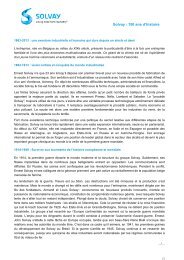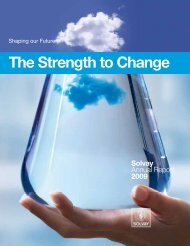THE FUTURE, - Solvay
THE FUTURE, - Solvay
THE FUTURE, - Solvay
You also want an ePaper? Increase the reach of your titles
YUMPU automatically turns print PDFs into web optimized ePapers that Google loves.
Sustainable<br />
development<br />
and citizenship<br />
54<br />
Sustainable development and citizenship > INNOVATIONS 09<br />
209983 210010 210034<br />
SCR: TOWARDS SECOND GENERATION NO X<br />
REDUCTION FOR DIESEL ENGINES<br />
Dinox ® for greener diesel<br />
engines!<br />
<strong>THE</strong> PROJECT. Diesel engines emit high levels<br />
of nitrogen oxides (NO x), which are harmful to<br />
human health and the environment. Standards in<br />
this area are also becoming increasingly stringent.<br />
The Dinox ® technology of ‘Selective Catalytic<br />
Reduction’ (SCR) developed by Inergy involves<br />
injecting an aqueous solution of urea (also known<br />
as AdBlue ® ) into the exhaust system. Unlike<br />
competing processes, it does not use a catalyst<br />
of rare metals. This technology also makes it<br />
possible to decouple engine tuning from<br />
the depollution function, thus enabling the motor<br />
to operate at optimal speed in terms of CO 2<br />
emissions.<br />
Inergy has developed a compact system that<br />
includes all functions needed to deliver Adblue ®<br />
to the exhaust: tank, injection pump, exhaust<br />
heater, pressure and level sensors, electrical<br />
connections and electronic supervision of the<br />
overall system.<br />
Developed with seven partners in six countries,<br />
this integrated system is fi nancially competitive.<br />
It has been validated in all real operating<br />
situations (arctic missions, very hot climates) and<br />
Inergy is currently regarded as one of only two<br />
credible suppliers in this new market.<br />
Selected by car manufacturers in Europe and the<br />
United States for production in 2011, this process<br />
should allow the development of diesel vehicles in<br />
North America and Asia. It could also encourage<br />
the development of controlled combustion<br />
gasoline engines, emitting very small amounts of<br />
CO 2 but producing more NO x.<br />
SBU INERGY<br />
> Frédéric Jannot; Joël Op de Beeck; Mike Ruzzin;<br />
Jim Thompson; Jules-Josep Van Schaftingen;<br />
Nadja Walling; Guillaume Zeller.<br />
<strong>THE</strong> SOLAR FRONTIER OF FLUORINATED<br />
FLUIDS<br />
Working safe above 150°C<br />
<strong>THE</strong> PROJECT. Renewable energies have<br />
been booming in recent years, and among them<br />
photovoltaic cells will probably be the ones to<br />
undergo the biggest changes. The surfaces of<br />
these cells are getting larger and larger, and<br />
applying therein photovoltaic materials in thin<br />
fi lms calls for highly dedicated manufacturing<br />
tools, to ensure uniform cooling rates. The<br />
challenge for producers of these cells is now to<br />
fi nd a coolant that enables operating process<br />
temperatures above 150°C while guaranteeing<br />
sound safety conditions. But the heat transfer<br />
fl uids available on the market, including<br />
de-ionized water and others widely used in the<br />
semiconductor industry, did not meet all the<br />
conditions: in particular their boiling point was too<br />
low (below 150°C) or they presented fi re risks and<br />
safety issues.<br />
<strong>Solvay</strong> Solexis came onto the scene, proposing<br />
new ultra high boiler Galden ® perfl uoropolyethers<br />
(PFPE). These new fl uids are easier to handle and<br />
remain operational throughout the life of the<br />
equipment (about 20 years). They also have the<br />
advantage of an excellent safety profi le, being<br />
non-toxic, non-fl ammable and inert, thereby<br />
improving health and safety conditions. This will<br />
satisfy the entire photovoltaic industry, with its<br />
undoubtedly double-digit growth prospects.<br />
SBU SPECIALTY POLYMERS<br />
> Francesco Triulzi; Giuliano Bernini; Roger Goyins;<br />
Vincent Meunier; Christina Osan; Enrico Repetto;<br />
Masanori Sasabuchi.<br />
EXPLORING A NEW SOURCE OF BRINE FROM<br />
DESALINATION PLANT WASTE<br />
One grain of salt too many<br />
in the sea<br />
<strong>THE</strong> PROJECT. Access to drinking water is<br />
one of the challenges of the 21 st century for<br />
certain Mediterranean countries. In Spain, a<br />
desalination plant providing between 20% and<br />
30% of Barcelona’s drinking water has been in<br />
operation since summer 2009. The desalination<br />
plant’s reverse-osmosis system processes sea<br />
water to produce drinking water and a waste<br />
product, concentrated brine, which has a negative<br />
impact on the fl ora and fauna (coral) around the<br />
plant outlet pipe. It would be a shame for this<br />
waste product, with such a high salt concentration<br />
(60 g to 80 g of salt per litre, compared to about<br />
30 g per litre in the sea), to go unused.<br />
This project therefore aims to reduce the amount<br />
of brine discharged into the sea by using it in an<br />
industrial process. By means of an electrodialysis<br />
process, the concentration of the discharge from<br />
the reverse-osmosis process can be increased to<br />
240 g per litre so the brine can then be purifi ed<br />
and used as a raw material in our membrane<br />
electrolysis process. This research project will<br />
indicate whether this alternative source of brine is<br />
cost effective compared to current sources of salt,<br />
and could provide for the optimal use of natural<br />
resources with zero environmental impact. To<br />
meet this challenge, our brine and electrolysis<br />
specialists in Italy are collaborating on the project<br />
with the Barcelona water company (Aguas de<br />
Barcelona - AGBAR) and the Universitat<br />
Politècnica de Catalunya (UPC).<br />
BSC IBERIA<br />
> Carlos Aladjem; Sandra Casas;<br />
Jose-Luis Cortina; Josep Flores; Enric Larrotcha;<br />
Florence Lutin; Fabio Mochi; José-Luis Ochando;<br />
Alessandra Pastacaldi.




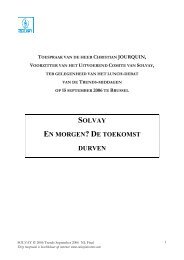
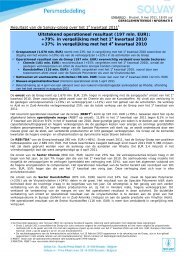

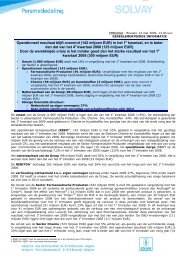


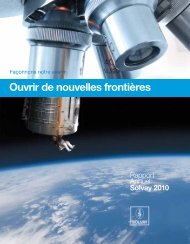
![PROC.1 [LETTRE] - Solvay](https://img.yumpu.com/16585746/1/184x260/proc1-lettre-solvay.jpg?quality=85)
